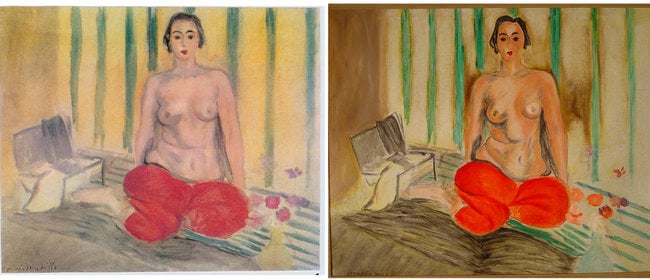
After nearly 15 years, a Henri Matisse masterpiece is back on display at Venezuela’s Museo de Arte Contemporaneo de Caracas Sofia Imber (MACCSI), alongside the poorly-made copy left behind by thieves, reports Reuters. The painting was returned to Venezuela over the summer (see “Stolen $3 Million Matisse Returns to Venezuela“), but the details of the case remain shrouded in mystery.
The $3 million Odalisque in Red Pants was rescued by the FBI in 2012, more than a decade after it went missing. Although the couple who attempted to sell the painting have since been convicted, no one has ever been charged with the original theft.
Even the exact date of the heist is unknown. The museum assumes it had been stolen by 2001, but Marianela Balbi, a Venezuelan journalist who authored The Kidnapping of the Odalisque, a book about the theft, believes it took place earlier, sometime after it was moved in anticipation of flooding in December 1999, but before mid-2000. The book cites museum negligence, but stops short of accusing corrupt officials of being involved.
The painting was next seen in Florida in 2002, during a period of unrest that briefly threatened Hugo Chávez’s rule, when a colonel in the Venezuelan National Guard tried to sell it to a gallery in Miami. Word of the painting reached Venezuela-born dealer Genaro Ambrosino, whose attempts to contact the museum were initially rebuffed.
“I was furious,” Ambrosino told Reuters. “So I sent an email to everyone I knew in the art world.” Shortly afterward, MACCSI was forced to admit the original Odalique had been stolen, and a fake version left in its place. It took ten years, during which time the canvas made its way to New York, Paris, and Mexico, but the FBI finally tracked down the real Matisse.
A Very Bad Copy
The forgery, done with acrylic paint instead of oil, is marred by a large brown stain in the center, and fails to correctly replicate key details, painting eight horizontal green stripes where the original has seven, and using a different shade of red for the topless woman’s iconic trousers. Now, visitors to MACCSI have the chance to view the two works side-by-side.
“It’s a very bad copy,” Venezuelan artist Elizabeth Cemborain told Reuters. “It doesn’t have the original’s design; it doesn’t have its elegance. I don’t understand how no one realized.”
MACCSI hopes the display, which includes an educational video comparing the two paintings, will educate viewers about the illegal trafficking of cultural goods.
For her part, Balbi is not a fan of the museum’s approach. “It’s absurd that they’re showing the copy, too,” she told Reuters. “It legitimizes the object of a crime that Venezuelan authorities haven’t done anything about in 12 years.”